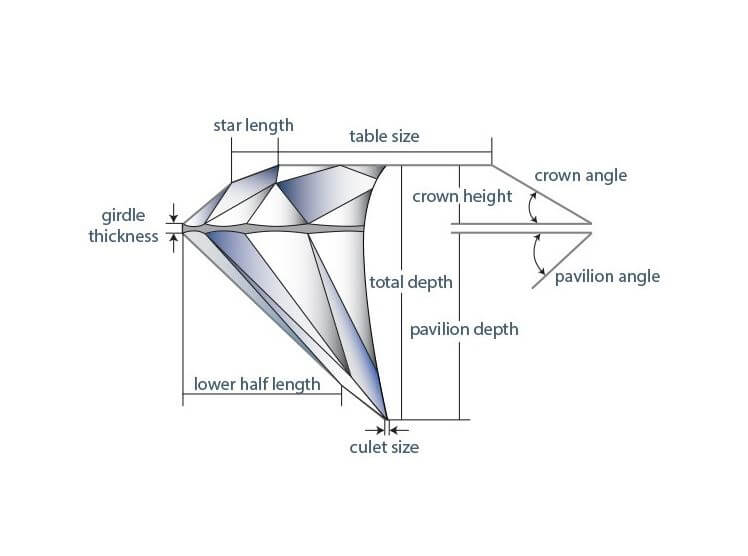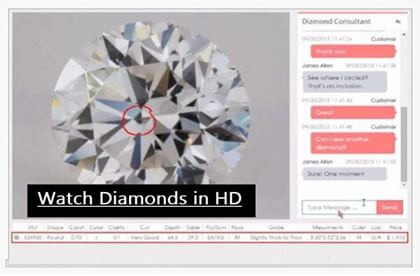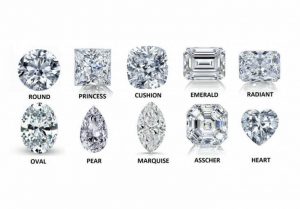Executive summary
Ideal diamond proportions are specific measurements of diamond parameters, in relation to the overall diameter of the diamond, used to determine the cut of a diamond. The light performance of a diamond is dependent on these proportions that determine its cut. The brilliance of a diamond determines the beauty of the diamond. If the diamond is not cut to the ideal proportions, it would lack the required brilliance, fire and scintillation, to the degree of its cut grade. But when a diamond is cut to ideal proportions, almost or all the light that enters the diamond will be reflected back to the eye of the viewer.
According to Marcel Tolkowsky’s thesis in 1919, titled “diamond design, a study of the reflection and refraction of light in a diamond!” the following are parameters that a diamond must have for it to have an excellent light performance and be considered a brilliant diamond.
| Table size | 53% |
| Crown height
|
16.2% |
| Crown angle | 34.5 degrees |
| Pavilion depth | 43.1% |
| Pavilion angle | 40.75 degrees |
A diamond with all of these parameters will invariably have an excellent light performance, will be a beautiful brilliant diamond with an excellent cut. Although more works have been done by renowned diamond laboratories like the GIA and they have discovered that there is a specific range for the different proportions that a diamond can have to be beautiful with excellent light performance. This is due to the faceoff between brilliance and fire determined by the crown angle and pavilion angle.
For a diamond to have an excellent cut, the most important parts of the diamond that determines this are the table and depth of the diamond. If the table and depth of a diamond are cut to their ideal proportions, the diamond will invariably have an excellent cut. The ideal proportions vary among different diamond cuts and shapes, so you have to pay attention to it specifically.
Ideal diamond proportions are specific measurements of the table size, crown height, pavilion depth, girdle, etc. of diamonds concerning the overall diameter of the diamond. These diamond proportions are used to determine a diamond’s cut. The cut of a diamond is the most important of the 4Cs of the diamond. It determines the brilliance, sparkle, and scintillation of a diamond. The ability of a diamond to refract light excellently is dependent on these proportions that determine its cut. The brilliance of a diamond determines the beauty of the diamond. If the diamond is not cut to the ideal proportions, it would lack the required brilliance, fire and scintillation, to the degree of its cut grade.
When a diamond is cut to ideal proportions, almost or all the light that enters the diamond will be reflected in the eye of the viewer. This is what defines the fire (the rainbow color that is observed in diamonds due to dispersion of light), scintillation and brilliance of a diamond (the ability of a diamond to reflect light to the eye of the viewer). The ideal proportions are specific measurement and very minute change to the proportions of parameters like table size, crown angle, etc. will affect the brilliance, scintillations, and fire of the diamond.
Marcel Tolkowsky, a renowned mathematician and gemologist in the 1900s, was one of the pioneers into the study of the ideal proportions required for a diamond to have an excellent cut. According to his thesis in 1919, titled “diamond design, a study of the reflection and refraction of light in a diamond!” the following are parameters that a diamond must have for it to have an excellent light performance and be considered a brilliant diamond.
| Table size | 53% |
| Crown height | 16.2% |
| Crown angle | 34.5 degrees |
| Pavilion depth | 43.1% |
| Pavilion angle | 40.75 degrees |
A diamond with the following cut parameters proposed by Tolkowsky will ultimately be beautiful and have an excellent light performance. Till date, these parameters are still very valid for a beautiful diamond. Although reputable grading laboratories like the GIA have carried out further studies into the ideal proportions for a diamond and have discovered that there is a specific range for the different proportions that a diamond can have to be beautiful with excellent light performance. Most times, this is due to the tradeoff between the fire of a diamond and its brilliance. This trade-off depends mainly on the measurements of crown angles and pavilion angles. It is therefore important to strike balance between the fire and brilliance of a diamond. Ordinarily, the more brilliant a diamond is, the lesser the fire of the diamond.
There are different ranges of these cut parameters for the different cuts of the diamond as shown in the table below.
| Cut | Depth % | Table % | Girdle | Culet | Length to Width Ratio |
| Ideal Princess Cut | 64 – 73 | 62 – 69 | Thin – Slightly Thick | None – Very Small | Square: 1.00 – 1.05
Rectangular: 1.49 – 1.73 |
| Ideal Oval Cut | 57 – 62 | 53 – 64 | Thin – Slightly Thick | None – Very Small | |
| Ideal Radiant Cut | 61 – 67 | 62 – 70 | Thin – Slightly Thick | None – Very Small | Square: 1.00 – 1.05
Rectangular: 1.20 – 1.31 |
| Ideal Cushion Cut | 61 – 67 | 61 – 68 | Thin – Slightly Thick | None – Very Small | Square: 1.00 – 1.05
Rectangular: 1.20 – 1.25 |
| Ideal Emerald Cut | 61 – 67 | 62 – 70 | Thin – Slightly Thick | None – Very Small | Square: 1.00 – 1.05
Rectangular: 1.39 – 1.50 |
| Ideal Asscher Cut | 61 – 67 | 62 – 70 | Thin – Slightly Thick | None – Very Small | |
| Ideal Marquise Cut | 57 – 62 | 53 – 64 | Thin – Slightly Thick | None – Very Small |
For round diamonds, there are two ‘ideal’ classifications. There is the super ideal round cut and the ideal round cut. The cut parameter table for round cut diamonds is shown below.
| Cut | Depth % | Table % | Crown Angle | Pavilion Depth | Girdle | Culet | Polish | Symmetry |
| Super Ideal Round Cut | 60 – 62.5 | 55 – 58 | 33.9 – 34.9 | 40.2 – 41 | Thin – Slightly Thick (2 – 3.5%) | None | Excellent | Excellent |
| Round Cut Diamond | 59 – 62.8 | 53 – 59 | 33.9 – 35.5 | 40 – 42 | Thin – Slightly Thick (1.5 – 4%) | None | Very Good To Excellent | Very Good To Excellent |
Importance of Table and Depth to a Diamond
The value of a diamond is determined by the different components of the 4Cs of diamonds. The cut of the diamond is the most important part of the 4Cs of the diamond and the major factors that determine the cut of a diamond are the table and depth of the diamond.
The Table of a Diamond
One feature that all diamonds have in common is a surface at the top that is flat and table-like. This is the part of the diamond that is called the table of the diamond. The surface of a modern round diamond has 58 facets and the table of the diamond is one of those facets. The table is the facet at the top of the diamond, as the light comes into the diamond through the top of the diamond, the table refracts the light to the facets at the sides of the diamond. This creates the unique and sparkling appearance of the diamond.
Ideal Size for the Table of a Diamond
The size of a diamond’s table is very important because it affects the overall appearance of the diamond. Its only function is not to allow light to enter into the diamond but it also disperses the entering light throughout the diamond. This allows the sparkle and brilliance throughout the different part of the diamond.
It is, however, important to ensure that the size of the diamond’s table is not unnecessarily bigger than it should be. A good diamond table has to be big enough to allow a lot of light enter into the diamond but it should not be so big that it is not able to refract light to the diamond’s crown. There has to be a balance between these two extremes for the size of the table to be considered as ideal.
The measurement of the table of a diamond is not based on physical measurements but is rather based on the percentage of the diamond’s width. The quality of a diamond’s table is also graded from excellent to poor like most of the other aspects of a diamond. There are different measurements for the table of a diamond for the different diamond cuts.
Round cut diamond: The table of the diamond should only take up between 54 – 60 percent of the overall width of the diamond if it is an excellent cut. If it is a very good cut, the table should take up 52 – 53 percent or 58 – 60 percent of the overall width of the diamond.
Princess cut diamond: The table of the diamond should only take up between 67 – 72 percent of the overall width of the diamond if it is an excellent cut. If it is a very good cut, the table should take up 56 – 66 percent or 73 – 75 percent of the overall width of the diamond.
Emerald cut diamond: The table of the diamond should only take up between 61 – 69 percent of the overall width of the diamond if it is an excellent cut. If it is a very good cut, the table should take up 57 – 60 percent or 70 – 72 percent of the overall width of the diamond.
Marquise cut diamond: The table of the diamond should only take up between 53 – 63 percent of the overall width of the diamond if it is an excellent cut. If it is a very good cut, the table should take up 52 percent or 64 – 65 percent of the overall width of the diamond.
Cushion cut diamond: The table of the diamond should only take up between 61 – 67.9 percent of the overall width of the diamond if it is an excellent cut. If it is a very good cut, the table should take up 58 – 60 percent or 68 – 70 percent of the overall width of the diamond.
If the table measurement for the different cuts listed above is outside the range given, it could negatively affect the overall outlook of the diamond. When the table of a diamond is too wide, it can cause a reduction in the dispersion of light throughout the different parts of the diamond. This will then cause the diamond to lack fire. This means that the fact that a diamond’s table is big doesn’t mean it is good and the diamond will have a good look.
The Depth of a Diamond
The depth of a diamond is another very important parameter in determining the cut grade of a diamond. It is important for the diamond is to achieve a visual balance with an optimal sparkle.
A diamond’s depth refers to measurement of the diamond from the top through to the bottom of the diamond (from the table at the top of the diamond to the culet at the base of the diamond). It is expressed as a percentage, while some grading reports also have diamond depth reported in millimeters. It is calculated by dividing the total height of the diamond by the total width of the diamond.
The depth of a diamond has a large impact on the overall appearance of the diamond. If a diamond is short and its depth is shallow, most of the light that come into the diamond will be able to just pass through the diamond from the top of the diamond to its bottom. This invariably reduces the fire and sparkle that is visible through the diamond. When a diamond is too deep, it also causes the diamond to lose its fire and sparkle. Due to the different distribution of weight, a diamond that is too deep can appear smaller and thinner than a diamond that is shallow even if they have the same carat weight.
The Ideal Diamond Depth
Very much like the diamond table, no one diamond depth works best for all the different diamond cuts. Therefore, the range of ideal diamond depth differs for different diamond cuts. The different diamond cuts have their range of diamond depth that can be graded from excellent to poor (like many other diamond parameters).
Round cut diamond: The ideal diamond depth for this cut ranges between 59 and 62.3 percent of the diamond’s total width for an excellent cut. If it is a very good cut, the ideal diamond depth should range from 58 – 58.9 or 62.4 – 63.5 percent.
Princess cut diamond: The ideal diamond depth for this cut ranges between 64 and 75 percent of the diamond’s total width for an excellent or a very good cut.
Emerald cut diamond: The ideal diamond depth for this cut ranges between 61 and 67 percent of the diamond’s total width for an excellent cut. If it is a very good cut, the ideal diamond depth should range from 59 – 60.9 or 67.1 – 70 percent.
Marquise cut diamond: The ideal diamond depth for this cut ranges between 58 and 62 percent of the diamond’s total width for an excellent cut. If it is a very good cut, the ideal diamond depth should range from 56 – 57.9 or 62.1 – 66 percent.
Cushion cut diamond: The ideal diamond depth for this cut ranges between 61 and 67 percent of the diamond’s total width for an excellent cut. If it is a very good cut, the ideal diamond depth should range from 58 – 60.9 or 67.1 – 70 percent.
Conclusion
The table and depth are very important for determining the cut grade of a diamond (which is the most important of the 4Cs of the diamond). So if you are going to be having a diamond in your hand with the necessary brilliance, sparkle, and fire, you must pay attention to the table and depth of the diamond that you are buying. There are however other things to consider as well, other members of the 4Cs (color, clarity and carat weight). For you to have a perfect diamond in your hand for the worth of your money, all these factors play important roles. While you can compromise on the color, clarity and carat weight of diamonds, do not do so for the cut. This means you have to take the table and depth of the diamond more seriously.




